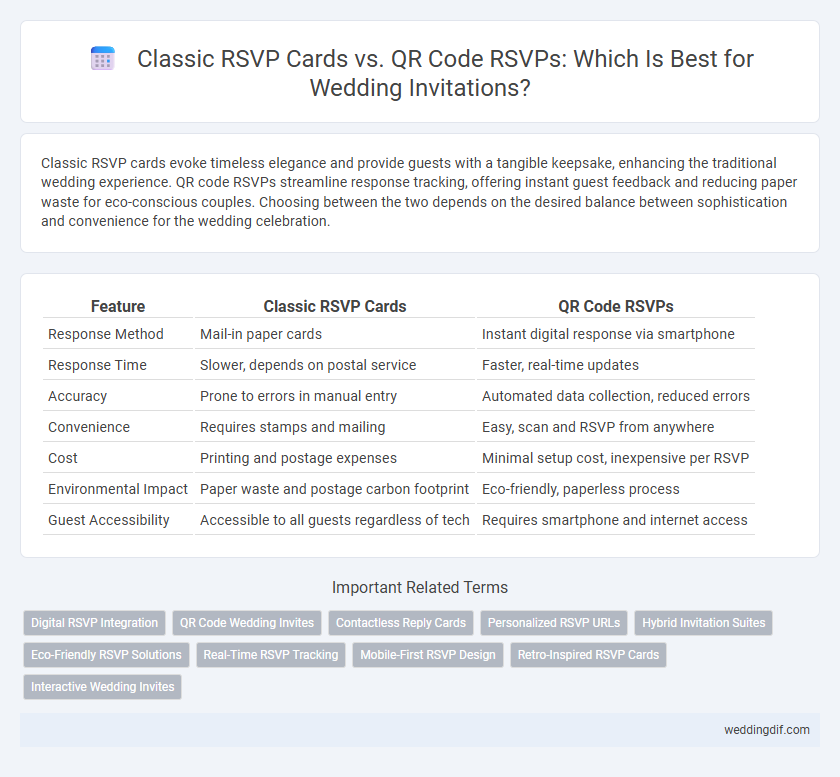Classic RSVP cards evoke timeless elegance and provide guests with a tangible keepsake, enhancing the traditional wedding experience. QR code RSVPs streamline response tracking, offering instant guest feedback and reducing paper waste for eco-conscious couples. Choosing between the two depends on the desired balance between sophistication and convenience for the wedding celebration.
Table of Comparison
| Feature | Classic RSVP Cards | QR Code RSVPs |
|---|---|---|
| Response Method | Mail-in paper cards | Instant digital response via smartphone |
| Response Time | Slower, depends on postal service | Faster, real-time updates |
| Accuracy | Prone to errors in manual entry | Automated data collection, reduced errors |
| Convenience | Requires stamps and mailing | Easy, scan and RSVP from anywhere |
| Cost | Printing and postage expenses | Minimal setup cost, inexpensive per RSVP |
| Environmental Impact | Paper waste and postage carbon footprint | Eco-friendly, paperless process |
| Guest Accessibility | Accessible to all guests regardless of tech | Requires smartphone and internet access |
Introduction to Wedding RSVP Methods
Classic RSVP cards remain a timeless option for wedding invitations, offering a tangible and elegant way for guests to respond. QR code RSVPs provide a modern, convenient alternative, enabling instant digital responses through smartphones and streamlining guest list management. Both methods serve the essential purpose of confirming attendance, with choices driven by personal style and technological preference.
What Are Classic RSVP Cards?
Classic RSVP cards are traditional paper inserts mailed with wedding invitations that guests use to confirm their attendance by filling out and returning the card. These cards often include options for meal preferences and a space for guests to write messages, maintaining a tangible and personal touch. Typically, couples use classic RSVP cards to keep track of guest counts and accommodate formal invite designs.
Understanding QR Code RSVP Technology
QR code RSVP technology streamlines wedding guest responses by linking invitations to digital reply platforms, reducing manual tracking errors and saving time. Unlike classic RSVP cards, QR codes offer instant access to event details, menu selections, and personalized updates, enhancing guest engagement. This method increases accuracy in headcounts and allows real-time monitoring of attendance data, supporting efficient event planning.
Comparing Guest Experience: Tradition vs. Convenience
Classic RSVP cards offer a tangible, personalized touch that many wedding guests appreciate, enhancing the sentimental value of the invitation process. QR code RSVPs provide unmatched convenience by allowing guests to respond instantly via smartphones, reducing response times and minimizing errors. While traditional RSVP cards emphasize formality and nostalgia, QR codes prioritize efficiency and ease, catering to tech-savvy attendees.
Design and Personalization Options
Classic RSVP cards offer a tactile, elegant feel with customizable paper textures, fonts, and envelopes, allowing couples to match their wedding theme intimately. QR code RSVPs provide dynamic design flexibility through digital platforms, enabling personalized online responses, multimedia inclusion, and real-time guest management. Both options cater to distinct personalization preferences, with classic cards emphasizing traditional aesthetics and QR codes enhancing interactive, modern engagement.
Cost Considerations: Paper vs. Digital Solutions
Classic RSVP cards typically incur higher costs due to printing, postage, and manual tracking, which can add up significantly for large guest lists. QR code RSVPs offer a cost-effective alternative by eliminating paper and mailing expenses, while streamlining response collection through digital platforms. Couples can reduce overall wedding invitation expenses by choosing QR code solutions without sacrificing guest engagement or convenience.
Tracking and Managing Wedding Responses
Classic RSVP cards offer a tangible way to collect guest responses but often require manual tracking and data entry, which can lead to errors and delays. QR code RSVPs streamline the process by allowing guests to respond instantly through digital platforms that automatically organize and update attendance data in real-time. This digital method enhances accuracy, simplifies guest management, and provides couples with immediate insights into their wedding guest list.
Accessibility and Inclusivity for All Guests
Classic RSVP cards offer tangible convenience for guests without smartphones and those preferring handwritten responses, ensuring inclusivity for all age groups and tech abilities. QR code RSVPs provide instant access and streamline response collection, but may inadvertently exclude guests with limited digital literacy or no internet access. Combining both methods maximizes accessibility, respecting diverse guest preferences and technological comfort levels.
Environmental Impact: Eco-friendly Choices
Classic RSVP cards generate significant paper waste, contributing to deforestation and increased landfill burden. QR code RSVPs reduce environmental impact by eliminating the need for physical cards, lowering paper consumption, and minimizing carbon footprints associated with mailing. Couples prioritizing eco-friendly wedding invitations benefit from digital RSVPs through sustainable practices and resource conservation.
Choosing the Best RSVP Method for Your Wedding
Classic RSVP cards provide a traditional and personal touch, ideal for couples seeking a formal and tangible response method that complements elegant wedding invitations. QR code RSVPs offer a modern, efficient solution by allowing guests to respond instantly via smartphones, reducing manual tracking and errors. Couples should weigh the formality of their event, guest tech-savviness, and convenience preferences when choosing between classic cards and digital QR code systems for seamless wedding planning.
Classic RSVP cards vs QR code RSVPs for weddings Infographic

 weddingdif.com
weddingdif.com